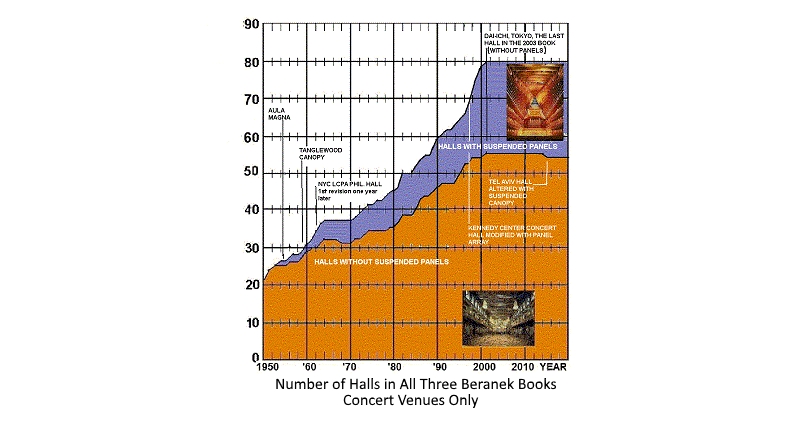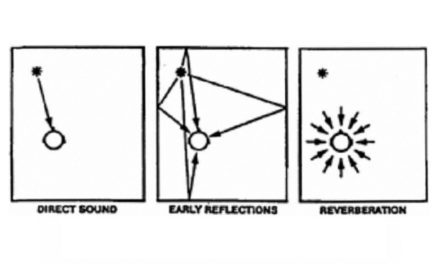by David Lloyd Klepper
Yeshivat Beit Orot, Shmuel ben Adiya 1, Mt. of Olives, Jerusalem 97400, Israel ddaveklepper1@gmail.com
I. Introduction
Leo L. Beranek was my major teacher in architectural acoustics, and without his instruction, influence, and inspiration, I would not have my 1957-1996 (primarily North American) architectural acoustics consulting career.1 His work in noise control has been considered so important that it is a part of general American history, particularly with regard to aviation,2 but also as one of the most important educators, authors, and innovators in the field of acoustics in general.3 Reasonably well-known among acoustical consultants and concert hall architects is his work on seat and audience sound-absorption that brought us more accurate prediction in design of reverberation time characteristics in completed halls and rooms.4,5,6 He and his firm, Bolt Beranek and Newman, were pioneers in the use of suspended sound-reflecting panels in halls for music. Here we shall trace the reasoning behind the use of this concept through a progression through the three concert-hall-opera house books, 1962-2003, and the halls with panel arrays discussed in those books, in comparison with those without such panels.7,8,9
The use of suspended sound-reflecting panels in concert halls and opera houses was not without controversy. Vern O. Knudsen and Cyril Harris never used them in acoustical design, although a few of their halls had such panels applied by others later. BBN’s own evaluation of the initial problems in the criticized Philharmonic Hall, was that part were due to the stepped nature of their placement and part due to the insufficiency of the openings’ area left by the panels,10 but Dr. Knudsen felt their use per-se contributed to the lack of bass response and subjective reverberation. Although no two halls are exactly the same, this argument might be refuted by the successful applications in other halls, as discussed in this paper and elsewhere.7
II. The Three Books and Available Data
The data for the halls is presented in same order a consistently applied in all three Beranek books. The books where the halls are discussed are referenced as follows: “1962” refers to Music Acoustics and Architecture, Wiley, New York, 1962; “1996” refers to Concert Halls and Opera Houses, How They Sound, Acoustical Society of America, Mellville, NY, 1996, “2003” refers to Concert Halls and Opera Houses, Music. Acoustics and Architecture, Acoustical Society of America, 2003, Melville, NY.7,8,9 The three classic halls recognized as outstanding, Vienna’a Grosser Musikvereinssaal, Amsterdam’s Concertgebouw, and Boston’s Symphony Hall, appeared in all three books, as did certain of the other halls. Others are in two of the books or only in one. For simplification, only data for occupied halls is shown, and when this is calculated from unoccupied data, the data is shown in italics. In certain cases disagreement exists between data taken at various times, both within one book and between the books. In such cases, this author has made the decision as to which data to use, based on knowledge of the measurement circumstances. Where data is available before and after drastic renovation, both before and after data is presented with an indication of the renovation changes. Halls with panel-arrays are noted by their names in italics. Starred halls (*) are in the 20 “excellent” list. All data is not necessarily from the consultant of record. Opera Houses not regularly used for orchestral concerts are omitted. In certain cases the applicable data is not shown in the three books’ tables, but only in the text describing the halls. This applies in certain cases where opera houses are regularly used as concert halls, with changes in acoustics resulting from the demountable stage enclosure replacing typical stage scenery, or the hall lacks a detailed post-remodeling measurement programs.
More information, detailed descriptions, and data can be obtained by consulting the three books. Not all measured data is included in this paper; the author is selective on what appears important and/or independently variable. The usefulness of the various measurements is discussed in detail in the three books, and the author takes exception only to Beranek’s discussion of Clarity C80 and the Initial Time Gap, T1. The reader is referred to this author’s earlier paper on this website, “An assessment of the importance of the early-to-reverberant sound-energy ratio, the metric “Clarity,” in concert hall acoustics.”11 Other references support my analysis.12
In this paper numbers are assigned to some halls, and may seem random. The reason is that where the hall was included the Clarity paper referred to, the numbers are the same to permit easy reference to data and figures there, just as the order in which the halls are presented assures easy reference to the 2003 Beranek book. Using data from all three books, one can gather the effects of remodeling efforts in certain of the halls, sometimes done twice. We go directly from data to evaluation of excellence, independent of Beranek’s intermediate step of assigning names for subjective impressions to each measured characteristic.
In this paper, numbers are assigned to some halls, and may seem random. The reason is that where the hall was included in the Clarity paper referred to, the numbers are the same to permit easy reference to data and figures there, just as the order in which the halls are presented assures easy reference to the 2003 Beranek book. Using data from all three books, one can gather the effects of remodeling efforts in certain of the halls, sometimes done twice. We go directly from data to evaluation of excellence, independent of Beranek’s intermediate step of assigning names for subjective impressions to each measured characteristic.
Seats Audience seating capacity, number of audience seats, seating area as defined by Beranek, with the area in square meters adding the orchestra on the stage.
Vol = volume. The number below is the volume divided by the effective total seating area as defined above, Beranek has given sufficient reason for the calculation to include the orchestra.
T1 Initial time gap, milliseconds between direct sound and the useful first reflection
RT Mid-frequency reverberation time, average of 500 and 1000 Hz (octave-bands). Time for decay of 60 deciBels after the sound source ceases. (I strongly object to the new standard of measuring only 30 deciBels of decay, discussed further in this paper.)
RT125 Same, but for 125 Hz octave band
C80 Clarity for music, ratio of early-to-reverberant energy with 80 ms. being the divi-ding time. Here, averages of the 500, 1000, and 2000 octave-bands.
EDT Early Decay Time, same as reverberation time, but only the first 10 deciBels and multiplied by six.
EDT125 Same, but for 125 Hz octave band.
BQI Binaural Quality Index, 1 – IACC, where the latter is the difference in level between the two ears, 0 – 80 milliseconds, in the 500, 1000, and 2000 Hz bands. Here only, unoccupied data is used because occupied data is unavailable, and Beranek concludes that where both sets of data are available that there is little change.
Acoustical Statistics of Selected Concert Halls & Opera Houses
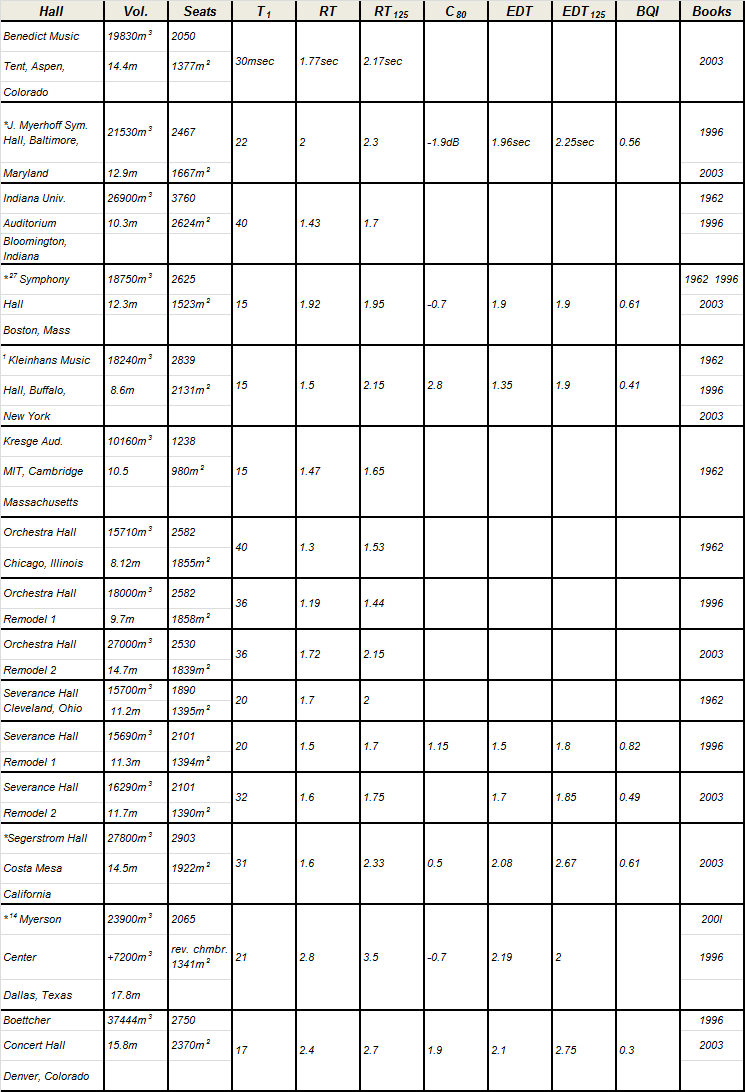
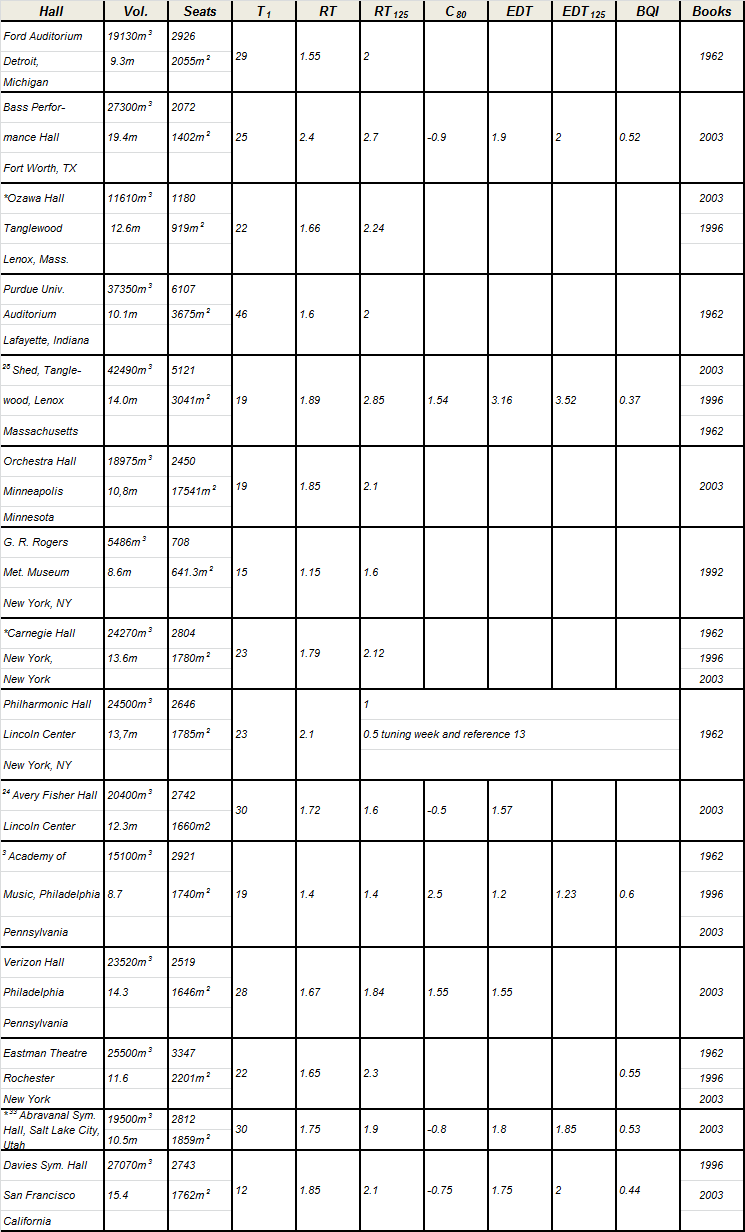
II. The Three Books and Available Data, continued
Acoustical Statistics of Selected Concert Halls & Opera Houses
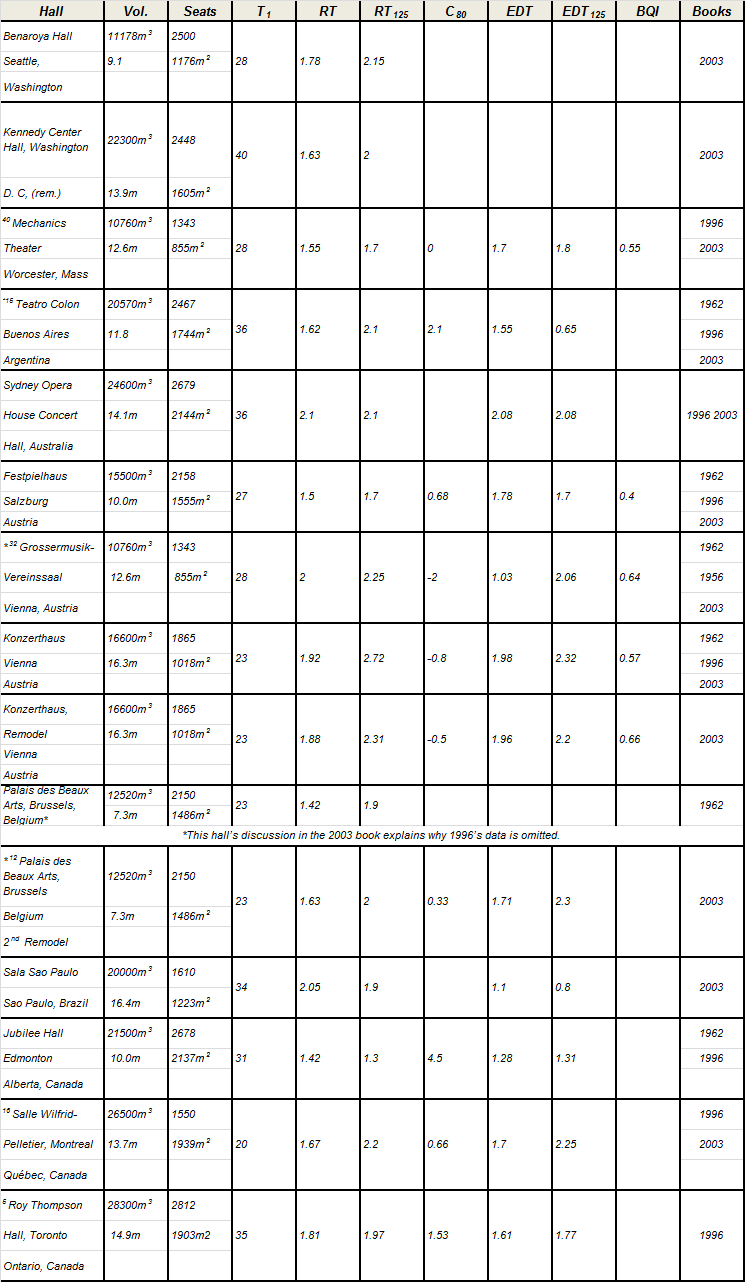
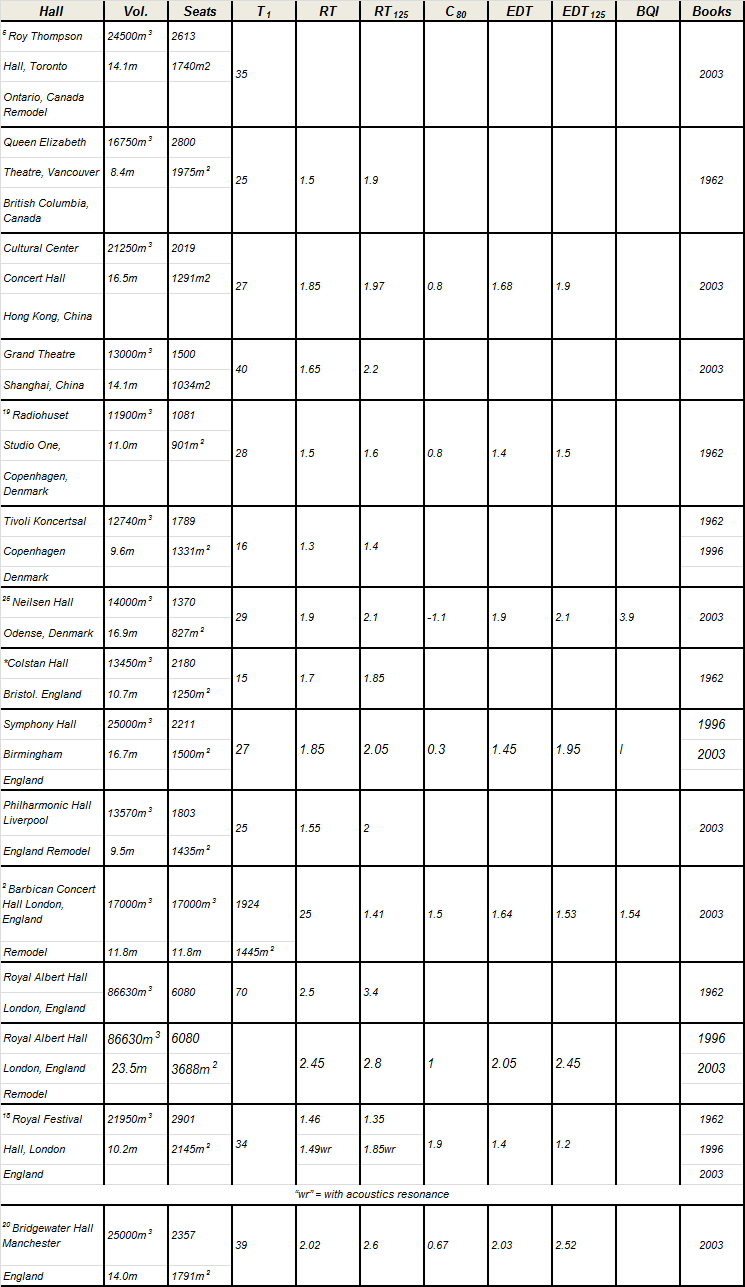
II. The Three Books and Available Data, continued
Acoustical Statistics of Selected Concert Halls & Opera Houses
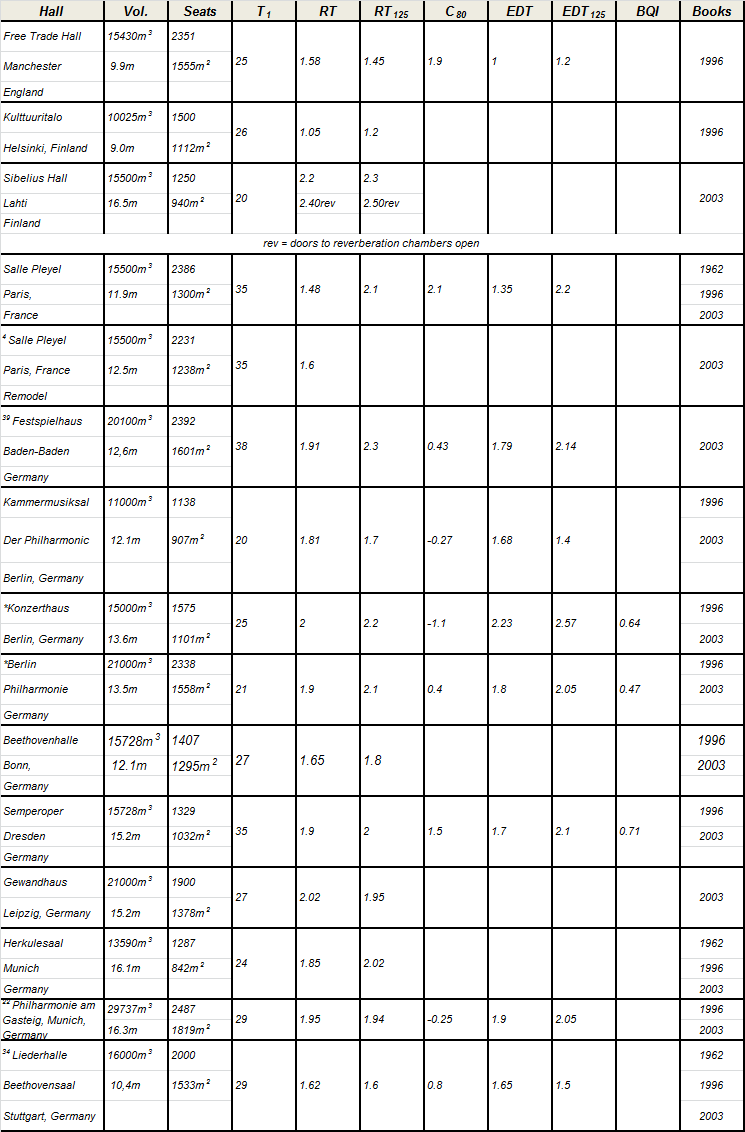
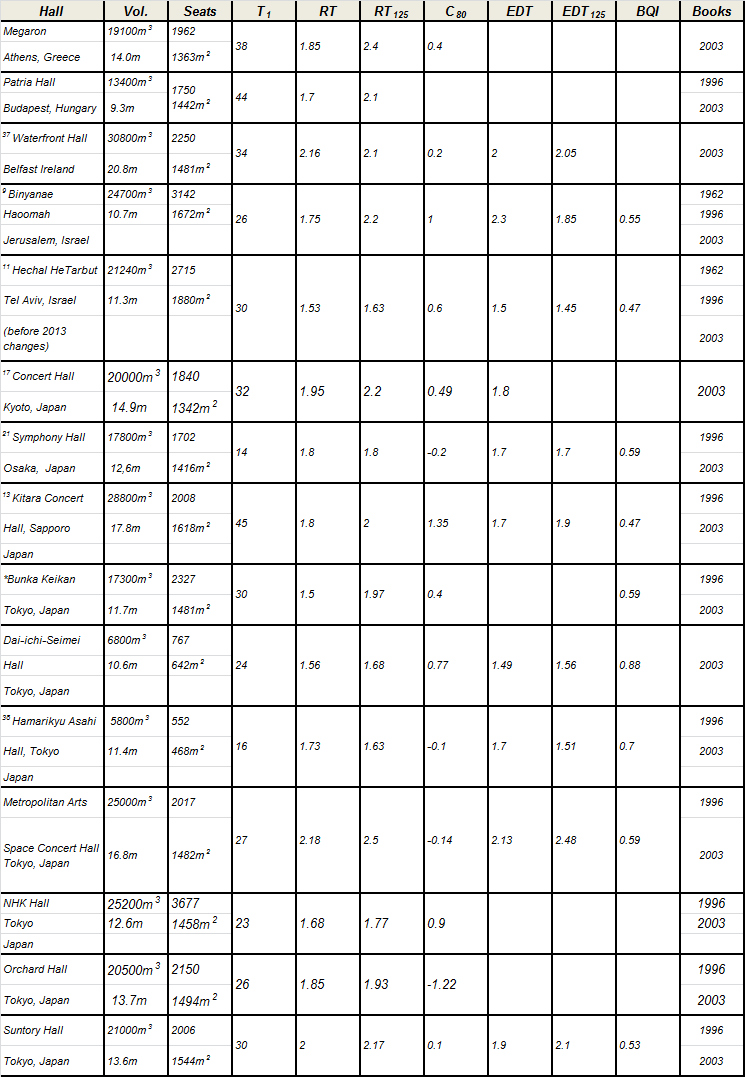
II. The Three Books and Available Data, continued
Acoustical Statistics of Selected Concert Halls & Opera Houses


III. Physical and Acoustical Data Correlated with Preference Data
A. With and Without Sound-Reflecting Panels
Bolt Beranek and Newman first used sound-reflecting suspended panels to cure predicted focusing effects of the domed ceiling of the Aula Magna in Caracas, Venezuela. The concept was later employed for Kresge Auditorium at MIT, Cambridge, Massachusetts, for the same reason. In both cases, the early reflected energy and greater clarity were appreciated by-products, but the theory of their application for this purpose and measurement techniques for evaluation were in the future. See pages 479-484 of Reference 7.
The first Bolt Beranek and Newman project that employed suspended sound-reflecting panels for specifically musical purposes was the 1959-1960 renovation of the 5000-seat “Music Shed” at Tanglewood, Lenox, Massachusetts, the summer home of the Boston Symphony. Here, the panels were intended to improve sound distribution and balance throughout the audience, improve clarity, and improve on-stage communication. They accomplished all these goals. Pages 93-98, Reference 7. The array of panels was planned to be about 50% open to the clear-space above, in part to provide the conductor and other musicians with some sound energy from the organ located above. The concept of the hall’s approximately two-second mid-frequency reverberation time (with full occupancy) as a very positive factor in the Shed’s acoustics was not really understood by one of the improvement program’s designers, and the original sketches showed the entire semi-circular rear wall open for the main ceiling to provide the best possible sound reflections to the lawn audience behind.
Figure 1: Quantity by year of halls included in the three Beranek books with and without sound-reflecting panels.
The matter was brought up at a conference at Symphony Hall, and the Symphony’s manager, Tod Perry, stated that reverberation time should be retained. The then-existing rear-wall configuration, with sloped panels to control echo installed at the recommendations of Professor Fay of MIT before WWII, was retained for the 1959 Summer Season. Ron McKay designed new sloped panels with both greater sound-diffusion and better appearance, and these were installed before the 1960 season. Eventually, Tom Horrall at BBN designed an excellent electronic sound-system for the lawn listeners, reinforcing without conflict (by use of digital delay) the live sound energy received through the open lower half of the rear wall.
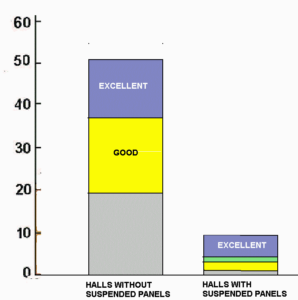
Figure 2: Halls with and without panels rated by excellence from Beranek interviews.
The single hall in green is the Tanglewood Shed. I would rate it as excellent, and so do all the musically informed people Beranek interviewed, I was a regular subscriber to the Boston Sym-phony at Symphony Hall, 1958-1967, and attended concerts at Tanglewood at least three times each summer during that period. Beranek said that the two reasons he de-rated the hall were (1) its fan-shape and size, and (2) less than optimum loudness because of the size. I would discount the first reason, and counter the second with the explanation that being in a country environment, with less background noise to live with than in the typical city environment of a typical concert hall, less loudness can be tolerated while retaining a sense of the beauty of the orchestral sound.
Only a fraction of the halls for which data is presented were subject to Dr. Beranek’s thorough musician and critic evaluation process, and only those halls are shown in Figure 2, from page 496, Reference 7 . In all cases, the opinions are those of the critics and musicians interviewed.
Figure 3 traces the history of Philharmonic Hall from its first season to its 1976 configuration as Avery Fisher Hall. For more detailed reasons, for its failure in the first season to please critics and musicians, Reference 10 should be consulted. A summary is that the stepped nature of the panel array produced phase cancellation in the fundamental cello frequency region, the same frequency region that is most attenuated in sound passing over flat-floor or nearly flat-floor seating; and the addition of a second layer of sound reflecting panels over the initial layer, due to false judgement neglecting unanticipated acoustical changes between tuning week and the completed building, reduced drastically the amount of reverberant energy reaching most listeners’ ears. The reverberation time was close to predictions, but Clarity was too high.
BBN’s recommendations addressed both problems and others, but a different group of consultants, based on the success of the Seattle Opera House,13 produced the design that existed for the hall’s second season. This used the panels to form one continuous panel from the stage to the rear, with reverberant sound reaching listeners only by reflections at the edges of the hall and at the rear. The alignment eliminated the first problem, but increased the second, the hall being judged good but far too “dry” or non-reverberant. In retrospect, this could have worked well if 50% opening large holes were installed or the canopy reduced in width and cut back to about two-thirds its length. The third year saw an attempt to solve the problems by eliminating the panels completely and installing a stepped ceiling, with care that the interference produced by the steps in the ceiling was not at the same frequency range as incurred by sound passing over seats. This renovation was a conventional auditorium design; it reduced volume and reverberation, while assuring even sound distribution.
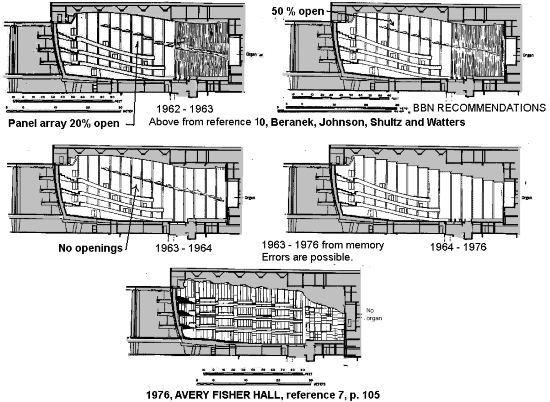
Figure 3. Philharmonic Hall – Avery Fisher Hall History.
It lasted for ten-plus years, until the acoustical consultant Cyril Harris and architect Philip Johnson were hired to produce Avery Fisher Hall, close in design to the successful Abravanal Hall in Salt Lake City and the later Benaroya Hall in Seattle, all being about as close as possible to the basic architectural design of Boston’s Symphony Hall, Amsterdam’s Concertgebouw, and Vienna’s Grosser Musikvereinssaal. The problem is that the design of these three halls is not directly expandable to larger seating areas without some acoustical compromise in one characteristic or another (compare the data), thus leading to the further revision, in design while I am writing.
Was the Lincoln Center management wrong in not allowing BBN the privilege of modifying the somewhat compromised design that existed the first season? (For the compromises, read References 10.) Or possibly have given the designers of the second-season installation the opportunity to modify it on the basis of new data? To me, personally, the answer is in the Ozawa concert hall at Tanglewood. Basically, this is a recreation of the Grosser Musikvereinssaal of Vienna, only slightly larger in volume, seat-count, and seating area, not as large as Symphony Hall, Boston, or the Amsterdam Concertgebouw. Yet, it has sound-reflecting panels. Unlike the Tanglewood Shed and Boston’s Symphony Hall, its use is not by primarily trained, mature musicians, but for concerts performed by the Tanglewood student orchestra and recitals by individual students among them. It is in the excellent rating by Beranek, and the 13th of the 20 in the list. Are there Boston Symphony musicians that will commit themselves to say that performing on the stage of Ozawa Hall is even easier than on Symphony Hall? The 5th in the list, the Tokyo Opera City Concert Hall, is also a hall with suspended sound-reflecting panels. Eight out of the excellent list’s twenty halls are panel-array halls, a majority of the list’s excellent halls constructed in the post-WWII period. Again, the list was prepared by evaluating interviews of musicians and critics.
The three books, particularly the 1996 and 2003 books, have many examples of successful panel-array designs, the earliest intended for music-acoustics being that at the Tanglewood Music Shed. In most concert halls, the array can be restricted to the stage and the front one-third of the audience area, and should be about 50%-open.
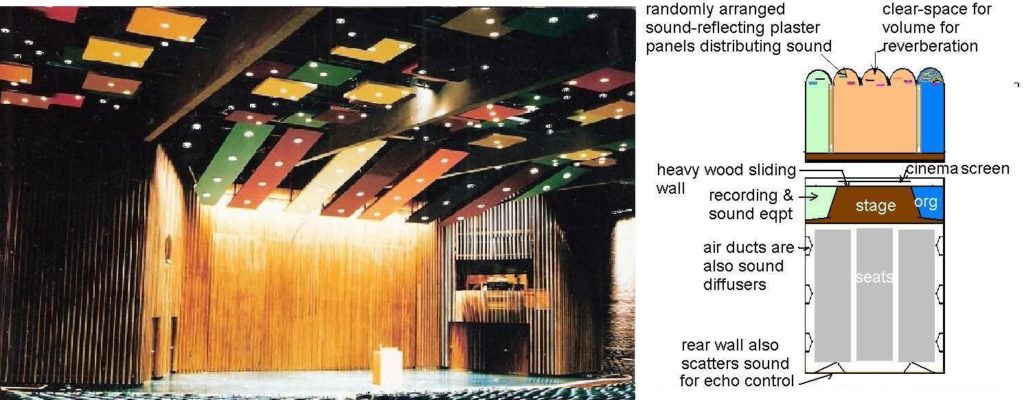
Figure 4. Spaulding Auditorium at Dartmouth College’s Hopkins Center, Hanover, New Hampshire.
Austin organ at right, recording and broadcasting control room at left. Harrison and Abromovitz, Architects, Walter Colvin Job Captain, a Bolt Beranek and Newman project.
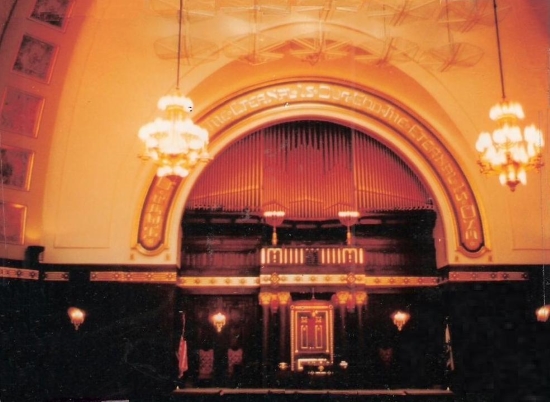
Figure 5. Congregation Rodeph Shalom, Pittsburgh, Pennsylvania.
Here, the panels remove the problem created by a focusing domed ceiling. A Klepper Marshall King project, with Ehrenkrantz, Eckstut and Whitelaw, Architects
If fixed or moved as a group, the panels should lie in a single tilted plane or the height differences between them should be randomized. Surfaces that provide a degree of diffusion may be better than plane flat surfaces. However, Figure 4 shows a 1962 design using flat-plane panels in a randomized configuration, both horizontally and vertically. Figure 5 shows light-transparent panels, all in one tilted plane, but with panel surfaces providing some sound-diffusion.
B. Hall Size
Of the three top-rated halls, the Concertgebouw is the largest in volume, 18780m3, but only slightly larger than Symphony Hall, which is the largest of the three in seat-count, 2625, and seating area 1523m2. The Tanglewood Music Shed approximately doubles these figures, but Beranek regards this as a special case, and perhaps we should, also. It is replicated, again in very quiet rural surroundings, by the Saratoga Performing Arts Center, summer home of the Philadelphia Orchestra. I have no measurement data on this hall, but my two orchestra concert listening experiences showed it to be comparable to Tanglewood, excellent in every way. (The first time I heard Samuel Barber’s beautiful “Nashville, Summer of 1915.”) The Saratoga hall uses one great suspended sound reflector, much like the Dallas concert hall that is No. 11 with 2065 seats, and in both these cases, one can simply wonder if there are disguised acoustical holes in the overall reflector or if all the reverberant energy is returned from the sides and rear. With L. Gerald Marshall and Larry S. King, I may have helped to provide another approximation at the summer home of the Rochester Philharmonic at the Canandaigua Performing Arts Center, Canandaigua, New York.
Costa Mesa, California’s Segerstrom Hall, with 27800m3 and 2903 audience seats for a total seating area of 1932m2, is the largest hall in Beranek’s list of twenty excellent halls, and it is 14th. An unusual panel array system is in use; the hall is not a typical design but is an asymmetrical fan-plan hall, and is worth studying in the 1996 and 2003 books.
A designer wishing to achieve an excellent concert hall with a size larger than 2500 seats with modern seating would do well to count on the use of suspended sound-reflecting panels below a sound-reflecting ceiling. If they are adjustable, in height and/or tilt, then fine-tuning and adaptability for different needs of different musical groups will be possible.
C. Volume/Seating Area and mid-frequency reverberation time
This ratio is critical to obtaining adequate reverberation time. For the top three, the range is 12.3 meters, Boston, to 14.6, Amsterdam. For all twenty, the range is 7.3 for the renovated Brussels Palais des Beaux-Arts, 19th of the twenty, to 17.8 for the Dallas, Texas, Meyerson Concert Hall, eleventh in the list. Within the twenty, the Dallas hall has the highest Reverberation Time, with 2.80 seconds, but easily adjustable. Tokyo’s Bunka Kaikan at 1.50 seconds is the lowest reverberation time, but I question whether the orchestral stage enclosure was in place for this measurement or whether it includes absorption by stage scenery. Within the top three, the range is only 1.92, Boston, to 2.00, both Vienna and Amsterdam. Half of the excellent halls are in the 1.80 – 2.05 seconds range, including all in the top seven, except for Buenos Aries’ Theatre Colon, where again I suspect the stage enclosure may not have been in use, and the absorption of stage scenery was included.
For many years, reverberation time was measures using chart recorders showing visually the decay of sound, and one would use protractors calibrated for use with the particular chart recorders to give a direct reading of reverberation time. Today, the tendency is to get direct readings from signal processing devices working with specialized sound sources. A new standard defines T30 with a value multiplied by two for only the first thirty deciBels of decay instead of the 60 required for a normal measurement. For popular music and speech, there should be no difficulty in using this standard, making the measurement less sensitive to background noise data distortion. However, some music does use the entire decay of a fortissimo sound for musical effect (Bach’s Toccata and Fugue in D minor, for organ or as orchestrated, one good example), and I would prefer to be able to examine the entire 60 deciBels of decay, preferably using the classic visual method. Beranek’s recommended minimum RT of 1.8 seems appropriate for me, but I would suggest his maximum of 2.1 could be raised if a C80 of -1.0 – -0.5, occupied, can be attained, at least to 2.3 seconds.
D. Reverberation time at 125Hz octave-band/mid-frequency reverberation time
In all three books, Beranek agrees with others that a rising reverberation time characteristic, along with the quality of “G” as energy efficiency, toward low frequencies is advisable. Nearly all the calls rated excellent have this characteristic. The single exception is St. David’s Hall, Cardiff, Wales, 10th on the list of excellence, which has a slightly lower reverberation time at 125 Hz, 1.88 seconds, then the average mid-band at 1.92 seconds. Should we question the accuracy of the measurements or find some other reason? But notice also that the bass rise for Symphony Hall, Boston is less than a tenth of a second. I still have similar questions concerning the acoustics of Holy Cross Cathedral, which has a fine reputation for the acoustics for choir, organ, congregational singing, yet also has a lower reverberation time at low frequencies than at mid-band, 2.2 seconds versus 2.9 seconds, fully occupied.14
My listening experience would tend to suggest that lower reverberation times at low-frequencies are most problematical in relatively non-reverberant (“dry”) halls. This hypothesis is suggested by the fact that none of the excellent halls have a 125-Hz-band reverberation time less than the 1.85 seconds of the Bristol hall. Boston with 1.95 seconds is the lowest of the top three, 2.25 for the Vienna Hall is the highest, with the Amsterdam hall at 2.21 almost as high. Among all the 20 halls rated excellent, the Dallas hall has the highest, far higher than others, at 3.5 seconds, controllable with doors closing on reverberation chambers. For a new hall, notwithstanding the Boston Cathedral experience, I would suggest a 125 Hz RT at least 10% higher than the mid-band value.
E. Clarity, C80, the ratio of early to late energy 500-2000 Hz, with 80 milliseconds the divider and T1
T1 is the time between direct sound and the first significant reflected energy. “ITDG” or “Initial Time Delay Gap.” Are delays evident in any other medium or dimension than time? Beranek switches between T1 and ITDG. We will use T1.
C80 for the top three ranges from -2.0 dB for the Vienna Grosser Musikvereinsaall to -0.7 for Symphony Hall, Boston, with the Amsterdam Concertgebouw at -0.97. Possibly either the measurement or my calculation to derive the occupancy value from empty data for the Vienna hall is in error, or both. (Subjectively, I found music clarity in the Vienna hall greater than in Amsterdam and similar to Boston,) In the entire list of the 20 of excellence, values range from a high of 2.0 dB to a low of -2.6 dB. But this 4.6 dB spread is a fraction of the total spread in all halls measured; the total range being 4.5 to -2.6dB. It is reasonable to aim for a C80 of -1.0 to -0.5 deciBels for the occupied hall, meaning an empty hall value of -2.0 to -1.5 with normal seating without excessive sound-absorption, but more seat absorption than in the older halls. Unless one copies an existing successful design, scale modeling and/or computer modeling is a necessity to be certain of success in this matter, or one can build in considerable adjustability (easiest to arrange with adjustable height and tilt of sound-reflecting panels) and schedules acoustical adjustment rehearsals before the hall’s opening.

Figure 6. With respect to Reverberation Time, RT, Figure 12.2, p. 482, Ref. 8, the 1996 book, at left, shows C80 has far more independence than EDT, as shown in Figure 4.3, p. 567, Ref. 7, the 2003 book, at right.
Proper use of sound-reflecting panels can provide independence for both. In both figures, the frequencies for measurement, 500 and 1000 Hz or 500 Hz alone, refer to octave bands, not single frequencies. Consult the two Beranek books for more details on these measurements.
T1 varies between 15 for Boston, to 21 for Amsterdam, and 28 for Vienna for the top three halls. Very few halls in the entire list exceed 40, and none of these are in the excellent list. Reference 11 suggests that avoidance of violating the Bolt-Doak rule for echo prevention should mean a T1 less than 40 milliseconds,15 but once that criterion is met, the actual value appears to me as not particularly important.11 If a hall without suspended panels is kept reasonable in size and has a suitable shape, or larger halls employ such panels, meeting this requirement should be easy by keeping the path-length distance difference between direct sound and that of the first reflection to less than 13 meters for most audience seats. Especially if chamber music is to be part of programming, 28 milliseconds or less is preferred, with the path difference nine meters or less.
Note that in addition to use of sound-reflecting panels, shaping of surfaces can effect changes in Clarity, C80, while keeping Reverberation Time constant. Tilted balcony fronts, splayed or tilted walls, etc., can be used to either maximize or minimize early reflections. Panels are most useful when adjustable.
F. Binaural Quality Index
The virtue of being enveloped by sound, rather than having it simply come in the direction of the stage, was long thought to be a desirable quality dependent on reverberation time alone. But in 1968 Keet showed that this Binaural Quality Index was a good measure of how envelopment in sound was perceived by the listener.16 It is not mentioned in the 1962 book. The three classic top halls have values close together, 0.54 for Amsterdam, 0.61 for Boston, and 0.67 for Vienna. The shoe-box plan, with reasonable diffusion on the walls, with either a tent-shaped ceiling or a diffuse flat ceiling, should insure values within this range. Other shapes and larger sizes than the classic halls will require the same kind of attention as the value of Clarity, C80. And note that the Tanglewood Shed, at 0.37, still gets excellent ratings from educated listeners.
Just as I would like to visually inspect the graphic representation of the decay of sound for reverberation measurements, so some graphic description, a “porcupine picture” of sound energy arriving at the listener showing, at least the 360-degree horizontal values and possibly the 180-degree spread of vertical values. Modern instrumentation and microphone techniques can produce such graphical representation, and it should be possible to include it in computer simulations and instrumentation of scale models, as well as measurement evaluation of existing and new halls.17 But the reference work is mainly geared to solving problems, most of all discreet echoes, in existing halls. To provide a guide to quality, differentiating between good and excellent, one might best use the technique for twelve measurements at each measurement location, 63, 125, and 250 octave-bands separate from 500, 1,000, and 2,000 octave-bands, and 0-80 milliseconds, and 80-2000 milliseconds, the last figure modified to account for the reverberation time and noise floor, this procedure in horizontal, and side-to-side and front-to-back vertical planes
IV. Correlation between some different physical and acoustical characteristics, shapes, and the future
Much of Beranek’s work in concert hall acoustics is based on statistics, which characteristics are evident in successful halls and which when lacking result in those less successful. In part, I have followed the same procedure. But this procedure can come to be wrong when we look at correlation between two acoustical characteristics. For example, Beranek is wrong when stating that Clarity, C80, is not worth measuring because it is closely correlated (negatively) with Reverberation Time.18 First, his Table 4.2 disproves his statement, rather than proving it. A correlation of -0.82 is inconsequential compared to one of -0.99, Early Decay Time with Reverberation Time.19 But even the slight loss of perfect correlation between EDT and RT (-0.99) shows enough independence to assure a concert hall designer that wide differences are possible, given the right architectural design approach. In the cases of both EDT and C80, suspended sound-reflecting panels can provide the independence for both characteristics.
Similarly, a rule limiting size to 2500 seats can be broken if the surrounding environment is particularly quiet. If the musical repertory is chosen carefully, lack of sufficient reverberation, or at the other extreme, too much with too low a value of Clarity, can still produce a musical result. Indianapolis Symphony Conductor Issler Solomon chose Mendelsohn’s “Midsummer Night’s Dream” incidental music to open the Christian Theological Seminary’s new theatre, music suited to the low reverberation time there. Dr. Beranek was very pleased with Tchaikovsky’s “1812 Overture” in the overly-reverberant (before the panel installation) Royal Albert Hall.20
None of the concert halls in any of the three books have perfectly flat and plane ceilings. Basically flat ceiling are normal, but with detailed recesses and protrusions that produce sound-diffusion, scattering. But an inverted V-shaped ceiling with the proper apex angles can also provide sufficient scattering, even if the surfaces are smooth. And construction costs for a given volume may, in many cases, be reduced.21
The Lakewood, Ohio, High-School Auditorium was a Bolt Beranek and Newman project. The community uses the auditorium as their civic auditorium, and a visit to the website shows some praise for its acoustics, when used for popular music groups. It was designed appropriately as a speech auditorium. Proud of the community’s accomplishment, George Szell, conductor, and the Cleveland Orchestra were invited to present an opening concert. George Szell was extremely displeased by the low reverberation time. I suspect his expressed displeasure was at least part of the reason BBN was not able to implement the changes recommended for Philharmonic Hall in the summer of 1963.
This paper is by no means intended to replace Dr. Beranek’s work. The vast amount of information contained in the three books, and particularly in the latter two, is invaluable to a concert hall designer. To be useful, this paper should be used in conjunction with the 1996 and/or the 2003 book.
More research, more measurements are needed. The data gaps in this paper should be filled. Not only should the Seattle Opera House and the Saratoga Performing Arts Center be added, but also St. Louis’ Powell Hall, Boston’s Jordan Hall and Berkeley School Concert Hall, Cambridge, Massachusetts’ Sanders Theatre, New York City’s Town Hall, the 92nd Street YMHA Hall, Tulley Hall, Bruno Walter Auditorium, Hunter College Auditorium and Play House, Brooklyn Academy of Music, Houston’s Jones Hall, Yale’s Wolseley Hal, Indianapolis’ Clowes Hall at Butler University, and the new Latter Day Saints Auditorium in Salt Lake City. The Maltings, at Snape, England is important, and also the two performance halls at Notre Dame University. The reader can add more. In addition, certain worship spaces can provide data on unusual shapes where music acoustics is excellent, Stamford’s 1st Presbyterian Church (the “Fish Church”), the circular but still diffuse MIT Chapel, the Air Force Academy Chapel, Congregation Beth El, Bloomfield Township, Michigan for starters.
But this paper added to either the 1996 or 2003 Beranek books should provide the architect with enough information to design an excellent concert hall or an excellent multi-purpose hall than can serve as a very good concert hall, without being forced to simply copy an old design. Or at least pick an old design to copy that meets all the client’s needs, not only acoustics. All that I ask is that the architect intelligently balance the needs for good acoustics, sight-lines, comfort, entrance and egress, distance from the stage, and safety, and not insist on a joke, such as a piano or ‘cello shape or anything else completely unrelated to optimizing the performing and listening environment. The Fish Church in Stamford, Connecticut, may seem to disprove even this rule, but Wallace Harrison probably had good acoustics in mind.21,22
V. Notes and references
1D. Malon and E. Wood, Sound Ideas, Acentech, Cambridge, MA, 2005, p. 62, 63, 76, 144, 186, 296, 332. My employment with BBN started 1 May 1957, not 1958.
2Chapter Two of the above reference.
3Honors and Awards:
Fellow of the American Academy of Arts and Sciences (1952)
Wallace Clement Sabine Medal of the Acoustical Society of America (1961) for internationally recognized achievements in all phases of architectural acoustics, and his publications on acoustical measurements, and the world’s great concert halls.
Gold Medal of the Audio Engineering Society (1971)
Gold Medal from the Acoustical Society of America (1975) for leadership in developing, in the United States and abroad, the desire and the capability for achieving good acoustics in communications, workplaces, concert halls, and communities.
National Medal of Science in Engineering (2002)
IEEE Founders Medal (2013)
Rayleigh Medal of the Institute of Acoustics, United Kingdom (2014)
Also see a Biography of Leo L. Beranek by R. David Read, Sound & Communications, June 2004, and also available on this website.
4L. L. Beranek, “Acoustics of the Frederick R. Mann Auditorium, Tel Aviv, Israel,” J. Acous. Soc. Am., 31, 882-895, 1959.
5L. L. Beranek, Audience and chair absorption in large halls”, J. Acous. Soc. Am., 45, No. 1, p. 13-19, 1969.
6L. L. Beranek and T, Hidaka, “Sound absorption in concert halls by seats, occupied and unoccupied, and by the hall’s interior surfaces”, J. Acous. Soc. Am., 104, 3169-3177, 1998
7L. L. Beranek, Concert Halls and Opera Houses, Music Acoustics and Architecture, Academic Press., Springer-Verlag. New York, 2003. p.501-502 for audience sound-absorption, Note that all acoustical terms and abbreviations used by this author are well-defined in this book, which has an excellent index and a comprehensive reference list. Available from the Acoustical Society of America. Note on pages 50 and 626, Symphony Hall, Boston, volume is 18750m3, not 8750m3. Page 499. The first sentence of paragraph under “Shape” is self-contradictory. Tanglewood’s Shed’s success proves an excellent fan-shaped hall is possible. Also there have been other excellent modern first-class halls, including the Pasadena Ambassador College Auditorium and the Northbridge Valley Performing Arts Center, both California, and Wellin Hall, Hamilton University, Clinton, NY. Page 500, The first sentence of the second paragraph is wrong. The Teatro Colon, Beunos Aries, Argentina, is excellent and horseshoe-opera-house-shaped, and the Berlin Hall, a surround hall, is further down in the excellent class. Page 527. The last sentence of the second paragraph should be interpreted to mean a lack of early reflections rather than a long reverberation time per-se. This is supported by Beranek’s comments on the Dallas hall on pages 75 and 79. The last sentence of the third paragraph should be omitted; it contradicts the data. As shown Table 4.2, page 529, Early Decay Time is almost perfectly correlated with Reverberation Time, 0.99, whereas Clarity is less at -0.84. Also see Figure 6 of this paper, above. On page 529, Table 4.2, the 0.88 correlation between Early Decay Time and Clarity, –0.88, should be shown boldface. Page 538, the last sentence of the second paragraph contradicts the data and should be removed. Again, Clarity can be shown to be reasonably independent, using Beranek’s data and the descriptions of those halls where panel arrays can be adjusted for optimum fit to musical requirements. A very small number of glitches compared to the vast amount of knowledge this book provides.
8L. L. Beranek, Concert and Opera Halls, How They Sound, Acoustical Society of America, Woodbury, New York, 1996. Again there are halls not included in the previous or following books. Some of my few quibbles noted for the reference above do not apply to this book.
9L. L. Beranek, Music Acoustics, and Architecture, Acoustical Society of America, New York, 1962. The music acoustics of Detroit’s Ford Auditorium was discussed in this book, but not included in the latter two Beranek concert hall books. Other halls discussed in this book, but not in the two later Beranek concert hall books, include Cambridge, Massachusetts, M. I. T., Kresge Auditorium; the N. Y. Metropolitan Museum’s Grace Rainey Rogers Auditorium. The original design for New York City’s Philharmonic Hall, never accurately and completely realized, is discussed in this book.
10L. L. Beranek, F. R. Johnson, T. Schultz, and B. Watters, “Acoustics of Phil-harmonic Hall during its First Season,” J. Acous. Soc. Am., 36 No. 7, p. 1247-1262, July, 1964; T. Schultz and B. Watters, “Propagation of sound across audience seating,” J. Acous. Soc. Am., 36 No. 5, p. 885-896, May, 1964; G. Sessler and J. West “Sound transmission across theatre seats,” J. Acous. Soc. Am., 36, No.9, p. 1725-1732, Sep. 1964.
11There are two website www.proaudioencyclopedia.com articles relevant to this paper: “An assessment of the importance of the early-to-reverberant sound-energy ratio, the metric “Clarity,” in concert hall acoustics;” “An autobiographical assessment of the importance of the early-to-reverberant sound-energy ratio, ‘Clarity,’ in speech acoustics.” The first is the reference sited.
12L. G. Marshall, “An acoustics measurement program for evaluating auditoriums based on the Early/Late Sound Energy Ratio,” J. Acous. Soc. Amer., 96, p. 2251-2261 1994; “An analysis procedure for room acoustics and sound amplification systems based on the Early/Late Sound Energy Ratio,” Journal of the Audio Engineering Society, (JAES) 44, p. 373-381, 1995, reprinted in Sound Reinforcement, 2, Audio Engineering Society, New York, p. 380-388, 1996: M. Kleiner, D. L. Klepper, and R. Torres, Worship Space Acoustics, J. Ross, Fort Lauderdale, p. 62, 2002; M. Long, Architectural Acoustics, Academic Press. New York, 2006, p. 671-674. Second Edition, p. 748-752, 2013. The definition of the term clarity factor as C80 is given on page 673 in the First Edition and p. 751 in the Second Edition. J. Eargle and C. Foreman, Audio Engineering for Sound Reinforcement, Hal Leonard and JBL Pro Audio Publications, Milwaukee, p. 218, 2002. W, Reichardt, A. Alim, and W. Schmidt, “Zusammenhang zwischen Klarheitsmass, C, und anderen objektiven raumakustischen Kriterien,” (Correspondence between the metric Clarity C and other objective criteria for room acoustics) Z. elektr. Inform, u. Energietchnik, Leipzig, 5, p. 144-155 1975 A. C. Gade and J. H. Rindel, Akustik I Danske Koncertsaale, (Acoustics in Danish Concert Halls) Publikation Nr. 22l, Laboratoriet for Akustik, Danmarks Tekniske Hoejskole, Lyngby, 1984; J. S. Bradley, “A comparison of three principal concert hall,” J. Acous. Soc. Am. 89, p. 1176-1192, 1991. M. D. Egan, Architectural Acoustics, McGraw-Hill. New York, NY 1988, p. 98. A. Kuusinen, J. Patynen, S. Tervo, and T. Lokki, “Relationships between preference ratings, sensory profiles, and acoustical measurements in concert halls,” J. Acous. Soc. Amer., 135-No 1, p. 239-250, 2014.
13Paul S. Veneklasen and Jerry P. Christoff, Seattle Opera House – Acoustical Design, The Journal of the Acoustical Society of America 36, p. 903, 1964. Note that this may be the first paper dealing with music acoustics spaces where the possibility of both clarity and reverberation is discussed in a hall where the concept is realized. However, missing completely is a discussion of the balance between the two effects. The impression is that while two second is the ideal reverberation time for symphonic music, clarity can be unlimited. The right balance in this hall was thus a matter of luck, the balance confirmed when I heard a symphony concert there with the acoustics approximating those of Jerusalem’s Binyanae HaOomah and typical Carnegie Hall seats for me at the time. Possibly the reverse may be proved, that reverberation time may be unlimited, but the correct balance with clarity is important, C80 of -1.0 to 1.0 in the occupied hall. The success of the Dallas Myerson Center concert hall, with 2.8 seconds RT and C80 of -0.7 occupied is a step in that direction.
14D. L. Klepper, “The Distributed Column Sound System at Holy Cross Cathedral, Boston, the Reconciliation of Speech and Music”, J. Acous. Soc. Am., 99:1, 417-425 (1996). The excellent 1875 Hook & Hastings organ in this Cathedral is discussed in B. Owen, The Organ in New England, The Sunbury, 1979, p.324-326, 600, 607, available from the Organ Historical Society, Richmond, VA,. But the organ is no longer neglected! (CDs are available.)
15H. Haas, “Uber den einfluss eines ienfachechos auf die Horsamkeit`von sprache,” Acoustica 1, I1951) p. 49-58. English translation by K. P. R. Ehrenberg as “The influence of a Single Echo on the Audibility of Speech,” Building Research Station Library Communication 363, Dec. 1949, Watford, Harts, England, reprinted in JAES, 20, March 1972, and in Sound Reinforcement, AES Anthology, 1978, Audio Eng. Soc, N.Y., p. C-20; R. H. Bolt and P. E. Doak, “A Tentative Criterion for the Short-term Transient Response of Auditoria” 15H. Haas, “Uber den einfluss eines ienfachechos auf die Horsamkeit`von sprache,” Acoustica 1, I1951) p. 49-58. English translation by K. P. R. Ehrenberg as “The influence of a Single Echo on the Audibility of Speech,” Building Research Station Library Communication 363, Dec. 1949, Watford, Harts, England, reprinted in JAES, 20, March 1972, and in Sound Reinforcement, AES Anthology, 1978, Audio Eng. Soc, N.Y., p. C-20; R. H. Bolt and P. E. Doak, “A Tentative Criterion for the Short-term Transient Response of Auditoria” J. Acous. Soc. Am., 22, p. 507-508, 1950.
16Reference 1, page 506, then 616. T. Okana, L, L. Beranek,T. Hidaka, “Relations among internal cross-correlation coefficient, IACCE, lateral fraction, LFE, and apparent source width, ASW, in concert halls, Jour. Acous. Soc, of Am. 104, p. 2398-2411, 1998; M. R. Schroeder, “Binaural dissimilarity and optimum ceilings for for concert halls: more lateral diffusion,” J. Acous. Soc. Am., 22, p. 958-963, 1963. These references will lead to others. The lateral fraction measurements are usually conducted both in the 0 – 80 millisecond and the post-80 millisecond time-frames. While it is the latter that provides enveloping reverberation, it is the earlier that both broadens source width and impresses the listener with closeness to the orchestra. If the design of the hall is satisfactory for the early sound arrival directions at the listener, it is almost impossible to design the hall that will at the same time not be satisfactory for the late arriving sound energy. Thus Beranek chose BQI, which is based on the 0-80 millisecond energy, and which also has the advantage of minimum difference between full and empty occupancy.
17A. Abdou and R. W. Guy, “Spatial information of sound fields for room-acoustics evaluation and diagnoses”, J. Acous. Soc. Am., 100:5, p. 3224-3225, Nov. 1996.
18Reference 7, p, 527, third paragraph, second and last sentence. The previous paragraph’s last sentence can also be disproved, in my opinion. All that is needed are the suspended panels to provide clarity in the cathedral-reverberant space.
19Reference 7, p. 529.
20Reference 7, p. 242. Also as reported in references 8 and 9 in the Royal Albert Hall discussions.
21D. L. Klepper, “Tent shaped concert halls, existing and future,” J. Acous. Soc. Am. 124, p. 15–18, July, 2008.
22D. L. Klepper, “First Presbyterian Church, Stamford, Connecticut,” J. Acous. Soc. Am. 31, No, 7, p. 879–882, July, 1959.
About the Author
David Lloyd Klepper is currently a student of Rabbinics at Yeshivat Beit Orot, Jerusalem, Israel, having moved to Israel in 1996 from his position as President of Klepper Marshall King, White Plains, NY, Acoustical Consultants, and as Adjunct Professor of Architectural Acoustics at City University, New York City. Before 1971 he was a senior consultant at Bolt Beranek and Newman, starting his consulting career there in May 1957. He received his SM and SB degrees in Electrical Engineering from MIT, and between times served as Assistant Audio-Radio Member of the PsyWar Board at Fort Bragg, NC, during the Korean conflict, leaving active duty as a 1st Lt. He provided acoustical advice for over 200 worship space buildings, including the National Presbyterian Church, Washington, DC, St. Thomas Church Fifth Avenue, New York City, the Capetown, South Africa, Anglican Cathedral, River Road Baptist Church, Richmond, Virginia, Young Israel of Southfield, Michigan, and Boston’s Holy Cross Cathedral. In this capacity, he was a pioneer in application of digital delay and electronic simulation of reverberation in worship spaces, and pew-back speech reinforcement. Publications include 40 papers in professional journals, a coauthor with Professor Kleiner and Father Rendell Torris of the book Worship Space Acoustics, JRosspub.com., and Editor of the two Sound Reinforcement Anthologies of the Audio Engineering Society. He is a fellow of both the Acoustical Society of America and the Audio Engineering Society, past Emeritus Board Certified member of the Institute of Noise Control Engineering, and a member of both the American Guild of Organists and the Organ Historical Society. He also belongs to a number of railroad and public transit interest organizations. You may contact Klepper at ddaveklepper1@gmail.com.

